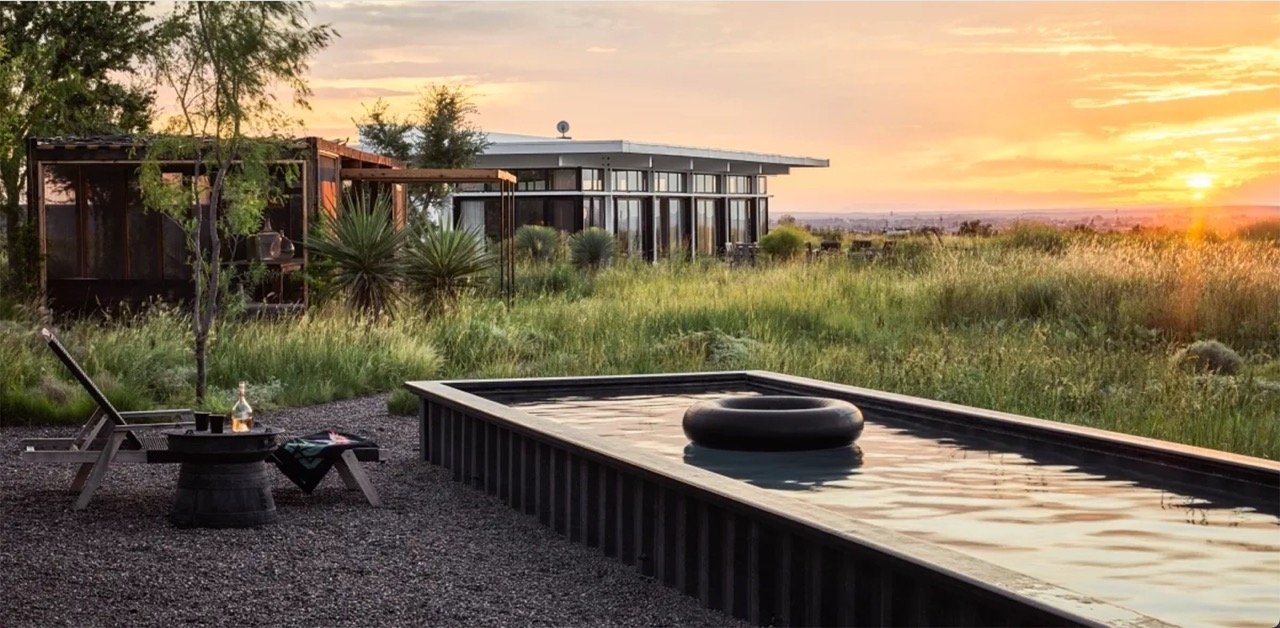The Aboveground Pool Is Chic Now
Why stock tanks, container pools, and other backyard solutions are finally getting their day in the sun.
As Published in Architectural Digest, July 26, 2022
Above ground pools are experiencing a renaissance, thanks to prefab solutions like stock tanks and Modpools, which are made from shipping containers. Here, a Modpool at the Marfa, Texas home of Douglas Friedman bears out the point. Photo: Douglas Friedman
Swimming pools seem like a great idea when a summer heat wave hits, but with the excavation and expense involved in the construction of a traditional in-ground pool, they don’t provide a last-minute solution. That’s why a once-maligned marvel of early-20th-century design—the aboveground pool—is finally enjoying its moment.
The first such pool was built for the Philadelphia Racquet Club in 1907, but the format didn’t become widely popular until after World War II, when it proliferated across the suburban landscape. If you’re imagining a lattice-clad eyesore and vivid turquoise, it’s time to update your mental map of backyard pool possibilities. Installing aboveground pools isn’t quite as simple as deploying a lemonade stand—their aesthetic won’t work for every backyard space, and they do require commitment. But in the right hands, they can be surprisingly stylish and, best of all, require no plumbing.
A stock tank pool by Cowboy Pools. Photo: Cristina Fisher / Cowboy Pools
One of the biggest trends in the aboveground pool space is the humble stock tank. These galvanized steel containers are used on farms to hold drinking water for livestock. They come in a variety of shapes and sizes, but the pool-curious usually choose a circular tank that’s about 10 feet wide. If you’re apprehensive about browsing a farm supply website, you’re not alone. That’s one reason Aaron Weiss and Amanda Shaftel founded Cowboy Pools in 2020, using funds from their pandemic-delayed wedding to start the company. Based in Austin, which gets at least six months of heat each year, Weiss and Shaftel offer tanks ranging from six to 10 feet, and each pool comes with all the gear you’ll need to keep the water clean and filtered.
To make it happen you’ll need about eight feet of yard, flat ground, and access to outdoor water and electricity. That’s partly thanks to the pair’s initial experimentation: “We became really excited about these little pools and after running into typical DIY challenges (tons of research, finding all the parts and equipment, trial and error), we had the idea to offer the full stock tank pool installation as a turnkey service,” Shaftel says. “[It’s] a way to keep cool in the Texas heat that’s practical, fun, affordable, and even kind of chic.” (Some designers have opted to undertake the stock tank experiment on their own: Eric Trine, the founder of Amigo Modern, made his own oasis for a summer at his California home, sharing the results with his Instagram followers and Domino.)
Unlike stock tanks, shipping containers aren’t designed to hold water per se, but with some customization they make lovely backyard oases. Modpools, founded in 2017 by Paul Rathnam, transforms used shipping containers into custom modular swimming pools such as this one, which keeps company with a Brett Douglas Hunter sculpture at photographer Douglas Friedman’s Marfa, Texas, compound. Shipping containers are usually 20 feet or 40 feet by eight feet, and can be altered inside Modpool’s factory. They can even add aquarium-like features, such as windows, and they can usually be installed in a day. Modpools and stock tanks can come with you if you move too. (Although aboveground pools are often covered under general homeowners’ insurance policies and don’t require separate policies like in-ground pools do, it’s worth reading the fine print to be sure.)
A daytime shot of Friedman’s cool pool in Marfa, Texas. Photo: Douglas Friedman
The vogue for transparency has left its mark on hotel amenities in warm weather locales like Mexico City, where the brutalist Hotel Carlota boasts a partially glassed-in pool that looks as much like a work of art as the building itself. But like stock tanks and shipping containers, this trend is finding its way into backyards too. American Sealants, Inc., which makes exhibits for aquariums and aquatic destinations like SeaWorld and Walt Disney World, has begun offering its services to homeowners keen to incorporate see-through acrylic pool walls into their designs. These pools certainly aren’t as easy to set up as a stock tank, and may require several weeks or more to install depending on the complexity of their design, but for the budding backyard mermaid, nothing else will do.



